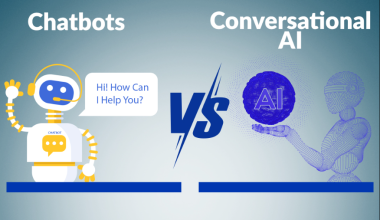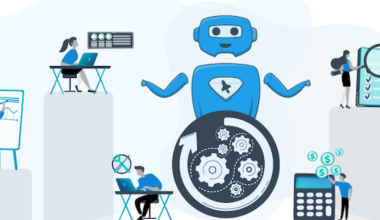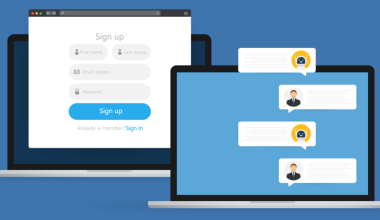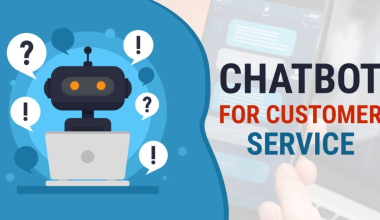Chatbots are like helpful robots on the computer that talk to people just like a friend would. They are here to make things easier by answering questions and helping with different tasks. This is an absolute beginner’s guide to what is a Chatbot, why we need it, how it works, use cases in different industries, and its limitations.
What is a Chatbot?
A chatbot is a computer program designed to mimic human conversation, serving to address customer inquiries and concerns across various communication channels. Whether customers or leads initiate contact, chatbots greet them and provide assistance or, facilitate tasks like service requests, sending emails etc.

These smart computer programs use words to chat with you, making it feel like you’re talking to a person. They are used in lots of places, like when you are shopping online or need help with something. Chatbots are becoming really important because they make things faster and better for all of us.
Drawing parallels to traditional telephonic customer care systems featuring automated options, chatbots essentially perform similar functions, albeit in a more advanced and interactive manner. Older phone trees were basic chatbots, but today’s versions use text, voice, or both to talk with customers, adapting their conversations to help meet the users’ needs.
Why do we need Chatbots?
Chatbots streamline customer interactions, improve efficiency, gather valuable data, enhance user experience, and adapt to evolving customer expectations, making them an indispensable tool. Here are the key benefits of chatbots to know about:
- Enhanced Customer Service: By handling repetitive queries, chatbots assist in resolving customer issues quickly. They can escalate complex queries to human agents seamlessly, ensuring a smoother customer service experience.
- Efficient Sales Process: They can act as lead generators, conversationally engaging potential customers. By gathering information and qualifying leads, they assist sales teams in focusing their efforts on leads most likely to convert, streamlining the funnel.
- Round-the-clock availability: Chatbots can be made available 24×7 even outside regular business hours! This immediate assistance ensures customer satisfaction
- Seamless Surveys and Data Collection: Chatbots facilitate the collection of customer feedback and survey responses conversationally. This data aids in understanding customer preferences, behaviour, and market insights, assisting businesses in making informed decisions.
- E-commerce Assistance: In e-commerce, they can assist in navigating the customer through the sales process, providing product information, and suggestions, and answering queries about payments, shipping, and policies. This can reduce cart abandonment rates and improve conversion rates.
- Improved User Experience: They provide a more personalized experience compared to traditional web browsing. They offer a conversational interface, making it easier for users to find information or complete tasks efficiently.
- Adaptation to Changing User Expectations: With the increasing use of mobile devices and the growing expectation for instant responses, chatbots offer a more user-friendly way to interact with websites.
There are many more benefits of Chatbots for business which make them a great addition to streamline operations.
What Industries are using Chatbots?
Several industries are leveraging chatbots for various purposes and improving their operations. E-commerce was the early adopter of them to assist them in sales, customer support, product inquiries, and improving the overall shopping experience. Small businesses can easily integrate them into their websites.
The service sector is now also embracing it, making it work with their existing customer care team. Chatbots assist customers with travel queries, and reservations and provide local information. In food delivery, they can handle food delivery orders, customer queries, order tracking, and improving the overall customer experience.
Banks are also using them to offer assistance with banking transactions, customer inquiries, financial advice, account management, and personalized services. HRs are using it well for aiding in recruitment, handling internal queries, and onboarding processes.
Other industries where chatbots are making a good entry are real estate and logistics, and the automobile industry.
These industries showcase the versatility of these bots in improving customer service, streamlining operations, enhancing user experiences, and providing efficient solutions across diverse sectors. You can learn about more use cases of Chatbots in real life for different industries.
Use Cases in Marketing & Customer Service
The use cases of chatbots in marketing and customer service are diverse and impactful.

Here are various ways businesses leverage chatbots to enhance their marketing strategies and customer service experiences:
- Help customers find products: Chatbots assist customers in discovering new products choosing the perfect product for the customer based on their preferences or finding the right variant for them.
- Respond to website visitors: They engage website visitors by welcoming them, scheduling appointments, and promptly addressing queries.
- Qualify leads: They assist in evaluating a customer’s likelihood to make a purchase. By pre-qualifying leads, chatbots help live agents focus on more promising prospects, optimizing efficiency in the sales process.
- Connect with agents: They facilitate scheduling calls, allowing customers to connect with suitable agents or managers based on their needs and preferred timelines. Meanwhile, the agent will be available, and bots can keep them engaged.
- Upsell and Cross-sell: They promote additional services or upgrades to existing customers, significantly impacting revenue generation by suggesting complementary products or service enhancements.
- Improve accessibility: They enhance user accessibility by integrating rich content like audio files, catering to visually impaired users or those preferring auditory content.
- Provide shipping information or Tracking: They assist customers by providing real-time updates and details about shipment tracking and delivery status, ensuring transparency and customer satisfaction.
- Answer FAQs: Bots can effectively address common customer questions in multiple languages, streamlining customer support and improving user experience.
- Book tickets: Chatbots guide customers through purchasing tickets for various events or activities, streamlining the ticket booking process.
- Process returns and refunds: They can handle return or refund requests, streamlining the process by verifying details and processing refunds efficiently.
- User onboarding: For software or products, they assist new users with onboarding processes, offering tutorials and guiding them through functionalities.
- Troubleshooting and technical support: Chatbots provide troubleshooting guides for technical issues, enhancing customer support without direct human intervention.
Other advantages you might want to know are they can be integrated with social media platforms (Facebook, WhatsApp etc), conduct surveys, and track user interactions. Here is a detailed blog on chatbot’s advantages for customer service.
Chatbot vs Live Chat vs Forms vs Email
The biggest plus point of a chatbot is it is always there to help, never sleeps, and talks to lots of people at the same time. It can understand what the customer says and can talk back to them. But it doesn’t feel emotions like humans do.
On the other hand, the competitor is Live Chat. A Live Agent can help you with questions or problems in real-time, which will feel more friendly and caring because it’s a real person. But sometimes they take a bit longer to reply and they also need breaks.
Before them, there were forms. Customers can fill in boxes on a computer asking for your name, email, or other things. You’ve probably done this when signing up for something online. They are easy to understand and lots of people use them. But they can be boring and people might not finish filling them out if they’re too long.
And then, there’s the good old Email! But in that situation, the customer has to enter the complete e-mail to the company, which is quite time-consuming and decreases the customer experience. Also, e-mail communication is not so user-friendly and may get lost somewhere as well. Overall, here is the simple summary of all this comparison:
- If you want quick help all the time, maybe use a chatbot!
- If you like talking to real people and want a friendlier experience, try live chat!
- Forms are good for collecting information but might be a bit boring.
- Email is great for sending messages to lots of people, but some people might not like too many emails.
Each one has good things and not-so-good things, so it depends on what you need and what makes your customers happy. Most businesses struggle with the first two options. Here is a detailed blog on Live Chat vs Chatbots.
How Does a Chatbot Work?
Chatbots, commonly found on business websites, appear as chat or voice prompts after a few minutes of browsing. They initially began as simple computer programs using keywords and pattern matching to respond to user queries from pre-written scripts.
Modern chatbots utilize advanced technologies like AI, ML, NLU, and NLP to deliver more human-like responses.

The functionality of chatbots depends on their programming. They can be categorized into two primary types based on their conversational style.
Rule-Based Chatbots
Rule-based chatbots, governed by predetermined rules and decision trees, rely on programmed guidelines to interact with users. Their functionality centres around the matching of keywords or phrases within a user’s input to a pre-established set of responses stored in their database.
They essentially operate as structured systems, working from scripted responses to engage in what can be likened to structured conversations.

Primarily functioning as interactive Frequently Asked Questions (FAQs), they excel in handling commonplace inquiries related to product or service features, pricing details, or contact information for customer support.
However, despite their efficiency, they can encounter limitations when faced with complex user inquiries that fall outside their programmed scope. Their inability to adapt beyond predefined rules restricts their capacity to handle variations within conversations, making them less suitable for addressing diverse user needs.
AI-Powered Chatbots
AI-powered chatbots represent a sophisticated evolution in conversational technology, harnessing cutting-edge advancements such as Natural Language Processing (NLP) and machine learning models.
These bots transcend traditional rule-based systems, exhibiting a remarkable ability to interpret user intent and the intricacies of conversation. They not only comprehend the explicit meaning of words but also grasp the underlying context and nuances embedded within conversations.
Distinguished as virtual or digital assistants, they employ a fusion of Natural Language Understanding (NLU), NLP, and AI/ML techniques. They adeptly analyze users’ behavioural patterns and profiles to deliver contextual responses that mirror human-like interactions.
Through continuous interactions, these digital assistants learn and adapt to users’ preferences, thereby refining their capabilities to provide personalized recommendations.

The hallmark of AI-powered chatbots lies in their capacity for dynamic and flexible interactions. Renowned examples of these conversational AI marvels include Amazon’s Alexa, Apple’s Siri, and Google’s Assistant.
You should be very careful when creating a good chatbot strategy.
Limitations & Challenges
Despite advancements in technology, there are still some limitations and challenges:
- Dependency on Training Data: They heavily rely on the quality and quantity of training data. Inaccurate or biased datasets can lead to incorrect responses or reinforce existing biases.
- Handling Complex Queries: Rule-based bots struggle with complex or ambiguous user queries that fall outside their programmed instructions. AI bots, although more adaptive, may face challenges in understanding highly nuanced or context-dependent conversations.
- Maintaining Context and Continuity: Ensuring that a chatbot maintains context throughout a conversation and seamlessly transitions between topics remains a challenge. Contextual understanding and memory retention are vital for providing coherent responses.
- Ethical and Privacy Concerns: As these virtual assistants become more integrated into various sectors, ensuring ethical usage, maintaining user privacy, and handling sensitive information securely are critical challenges.
But if you are already aware of chatbot mistakes, you can definitely overcome them by implementing them correctly.
Future with Conversational AI
Conversational AI holds immense potential for the future. Advanced chatbots powered by AI technologies can significantly improve customer service by providing quicker responses, 24/7 availability, and personalized interactions. This streamlines operations across various industries, reducing costs and increasing efficiency.
With ongoing advancements in AI, including NLP, NLU, NLG, and machine learning, chatbots are expected to become more adept at understanding human intent, emotions, and preferences, leading to more natural and intuitive interactions.
The future with conversational AI holds promise for revolutionizing how businesses interact with customers and streamline operations, but overcoming challenges related to data quality, context understanding, and ethical considerations will be crucial for maximizing its potential. Conversational AI and Chatbots are slightly different from each other.
How to build an AI Chatbot for your Website?
Building an AI Chatbot for your website is an innovative way to enhance user experience, automate customer interactions, and provide instant support. With advancements in artificial intelligence, creating a personalized chatbot tailored to your website’s needs has become more accessible.
By leveraging specialized platforms or tools, businesses can train their chatbots to understand user queries, provide relevant information, and engage visitors effectively. This process involves gathering data, training the chatbot, designing conversation flows, and seamlessly integrating the chatbot onto the website.
The result is a responsive and intelligent chatbot capable of handling various user inquiries round-the-clock, contributing significantly to customer satisfaction and operational efficiency. Here are the steps to build an AI chatbot:
- Define Objectives: Determine the purpose of the chatbot (e.g., customer support, lead generation, FAQs). Identify the specific tasks it should handle.
- Choose a Platform: Research and select a chatbot-building platform or tool based on your requirements. Consider factors like customization options, integration capabilities, and the AI model used.
- Gather and Prepare Data: Collect relevant data such as FAQs, product information, support queries, or any content it will need to learn from.
- Train the Chatbot: Use the chosen platform’s training features to input and teach the bot from the collected data.
- Design Conversation Flows: Create conversation flows or dialogue trees defining how they interact with users for different scenarios or queries.
- Test and Refine: Test the chatbot extensively to identify and fix any errors or shortcomings in its responses.
- Integrate with Website: Deploy the chatbot onto your website using integration methods provided by the chosen platform.
- Monitor and Update: Monitor the performance and user feedback to make ongoing improvements. Regularly update it with new information to enhance its capabilities.
Chatclient is an easy AI-powered chatbot builder designed to simplify the creation of customized bots specifically tailored for businesses.
Users can upload diverse file formats, including PDFs, TXT, CSV, and DOCX files, or link their website for seamless content extraction. ChatClient allows users to select specific documents or pages and then initiate the training process with a single click.

Upon completion of training, users obtain an AI chatbot exclusively trained on their provided content, capable of delivering instant responses tailored to user queries, available 24/7.
We have a friendly user-friendly interface, coupled with its powerful AI capabilities By simplifying the process, we offer an effective solution for businesses seeking to improve customer engagement on their websites.
Takeaways
This might be a good and thorough introduction to the world of Chatbots. They are like friendly helpers on the internet that make our lives simpler. Many businesses use them to talk to customers and give them quick answers or assistance. They make things faster and more convenient, like finding products online or getting help anytime, day or night.





